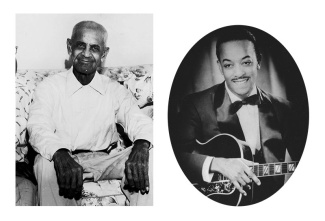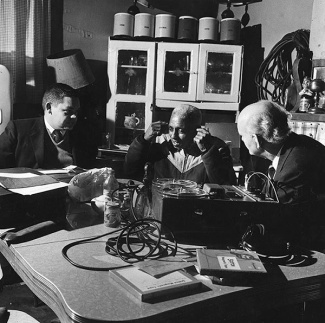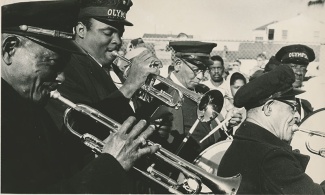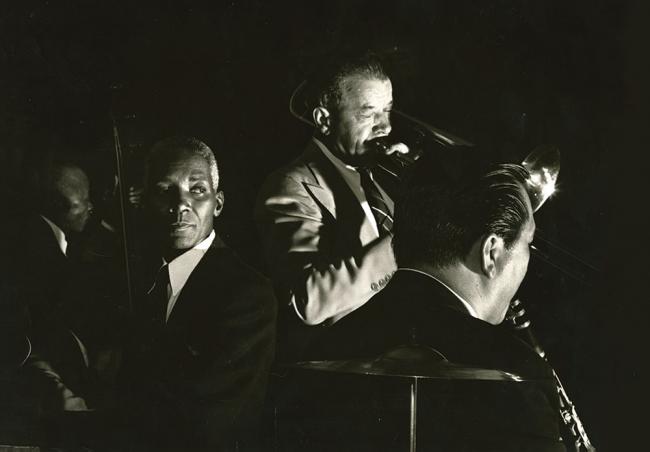That’s the hat. Yes, it’s the very one that jazz guitarist and raconteur Danny Barker wore. Deep in the recesses of the Hogan Jazz Archive, cocked discreetly on a shelf, is a taupe-colored fedora with a wide brown ribbon and a deep dent in the center of the crown. It’s easy to overlook, given all there is to see down here—yards and yards of sheet music and precious vinyl recordings, letters, books, old phonographs, musical instruments.
In the mid-1960s, the head on which that particular hat sat had the brilliant idea to save what was then a struggling brass band tradition in New Orleans. If Barker and his Fairview Baptist Church Christian Band had not inspired future generations of young people to reclaim their musical heritage, New Orleans would be a different place entirely. A quieter place. With fern bars. And better traffic flow. But an important part of the city’s soundscape—the social aid and pleasure club parades and the jazz funerals and all the music-filled traditions that mark the bonds of community and the passage of time—would be a memory.
The Hogan is one of the last two major university jazz archives in the nation (the other is at Rutgers) and is essential to the world’s understanding of the beginnings of jazz, black gospel music of the 20th century and the golden era of New Orleans R&B. Its more than 2,000 tapes of oral histories are a never-ending cache of teachable moments for musicians, academics and fans.
Deep Dive in the Jazz Archive
New Orleans jazz is a living, breathing, evolving force, but its origins in the early 20th century require special preservation. That is the job of the Hogan Jazz Archive.
New Orleans jazz is a living, breathing, evolving force, but its origins in the early 20th century require special preservation. That is the job of the Hogan Jazz Archive.

“The artifacts speak to you because they’re not just surface-level artifacts,” said ethnomusicologist and Tulane associate professor of music Matt Sakakeeny. “Let’s say it was 1959 and Richard B. Allen, one of the Hogan’s first curators, is going out to interview the Barbarin family about their place in the New Orleans jazz tradition. Well, it’s not until you get to the archive do you understand that he’s showing up at the door with a portable reel-to-reel recorder, a giant machine. So, now you know (the Barbarins’) address. He would type up his notes so you might understand what a person was wearing that day, or how old they were or what kind of shape they were in, what family members were around. Also included is a letter that the archivist has from the city—because it’s Jim Crow and a white man like Allen is not legally allowed to go into the space of a black family or even sit in a bar with a black patron. So, these archivists had official letters from the city saying, ‘Police, don’t obstruct this work that is being undertaken.’ Maybe that gives you a sense of the dynamics of an oral history interview.”
The Barbarins are one of many musical families in New Orleans, and mellophone player Isidore Barbarin was Danny Barker’s maternal grandfather. Barker’s cousin, Charles Barbarin Sr., was a co-leader of the Fairview band. A drummer in the family, Uncle Paul Barbarin, played frequently with Louis Armstrong and wrote “Bourbon Street Parade,” one of the best-known songs in the New Orleans canon. And yet, no stranger walking into the Hogan Jazz Archive, located at Jones Hall on Tulane’s uptown campus, would guess that, or suspect any of the treasures that lie within the archive’s closed stacks.
It’s quiet in here. Like, “Twin-Peaks’’-David-Lynch-what’s-gonna-happen-next quiet. Less really is more when it comes to noise in a place where people are trying to think.
But the archivists fill the void—Alaina Hebert, Lynn Abbott and, for more than 40 years, curator Bruce Raeburn. They steer visitors to materials that might excite them. They also send visitors to the archive’s glass-encased listening rooms to hear recordings at full blast (OK, full-ish). Researchers from the entire jazz diaspora come to consult with them—Europe, Japan, Australia, China, Canada, Alaska, the Seventh Ward of New Orleans, Pontchartrain Park and even Dixon Hall on Tulane’s campus. For Sakakeeny, input from Hogan archivists led to an unexpected discovery.
While researching his 2013 book Roll With It: Brass Bands in the Streets of New Orleans, Sakakeeny found evidence that shed new light on old assumptions about New Orleans brass band music. Like nearly everyone else, he’d thought the Dirty Dozen and Rebirth brass bands were transformative—the first to build their repertoires from popular, danceable, radio-friendly music. But the fabled Olympia Brass Band, a favorite of traditional jazz purists, apparently felt like funkin’ it up,* as well. Archivists at the Hogan showed Sakakeeny vertical files of news clippings, songs and other ephemera that revealed a friskier Olympia. Turns out, they were doing what the younger Dirty Dozen and Rebirth were doing, but more than 20 years earlier.
“They were the hot, new, current band of the 1950s when Fats Domino and Professor Longhair and Dave Bartholomew were making New Orleans the center of R&B and soul and eventually funk music,” Sakakeeny said. “Olympia was playing that style of music in this ancient brass band ensemble. So I realized the story of the Olympia being these tradition-bearers was only part of the story.”

Jazz Letters
Jazz pianist and bandleader Jesse McBride is usually on the lookout for vinyl. After studying under the likes of Ellis Marsalis and multi-instrumentalist Harold Battiste at the University of New Orleans, McBride earned a master’s degree in musicology at Tulane in 2011 and is now a professor of practice. He takes his students to the Hogan, usually one at a time, and together they listen to vintage recordings and sometimes transcribe the melodies. “There are so many records that can never be put on a CD—and even CDs are really done now,” he said. “From the 1920s to the 1980s, there are some recordings that are only on LP, especially jazz recordings. Think about all the Cedar Walton records that got put out and how many will never be reproduced. Walton was a great pianist. He played with Art Blakey. He actually went to Dillard (University) with Harold and Ellis.”
McBride asks his students what they want to hear and then pushes them toward a warren of rabbit holes. Case in point—the Tulane undergraduate listening to stride piano player James P. Johnson, the man who taught Fats Waller and accompanied Bessie Smith on “Backwater Blues.” Johnson wrote popular and classical music, including an opera in one act with librettist Langston Hughes.
“(My student) was listening to ‘Carolina Shout.’ That’s a great tune,” McBride said. “I said, ‘I know a place where we can go listen on LP, because you might want to hear it the way it came out, when it was released. Then, in looking through those James P. records, we can just see who’s around there alphabetically. If Johnson is there, ‘H’ ain’t too far. Go to (pianist Earl) ‘Fatha’ Hines and check out his records. ‘L’ ain’t too far. Check you out some Lil Hardin playing on a Louis Armstrong record. Or, let’s maybe explore and see if anybody has recorded ‘Carolina Shout’ in a different era. Or we could hear someone that was influenced by Johnson.’”
McBride is also eager to contextualize the contributions of musicians whose lifework reflects the often troubled times in which they lived—segregation, ill health, personal danger. “They attacked Nat ‘King’ Cole onstage,” he said, alluding to a 1965 incident in Birmingham, Alabama, when Cole was singing to an all-white audience and segregationists rushed the stage, injuring his back. “They attacked Harold,” McBride said, remembering that his mentor—Harold Battiste—was evacuated from a concert in the South while touring with Sonny & Cher. Battiste—a black man—was their musical director.
“He tells them stuff they need to hear,” said archivist Lynn Abbott. “He tells them the truth.”
Down on the bottom floor of the archive, there’s an infinity of truth. Abbott opens a box plainly marked:
Al Hirt papers, 1959–1977
MSS 006
Series 3: Correspondence Re: Lip Injury
Box 5 of 8
In 1970, the Dixieland trumpeter’s career was in doubt. A flying brick split open Hirt’s lip during a carnival parade. The New York Times reported the incident in a story titled, “New Orleans Ends the Most Violent Mardi Gras Season in Years with 600 in Its Jail.” Hirt required stitches, which threatened his embouchure, and the outpouring of public support was immediate. But, like all good artifacts, the letters raise as many questions as the brick:
From Vancouver, B.C., Canada:
Big Al—Don’t lose your cool, man.
—Small Al
And from Iowa City, Iowa:
Dear Mr. Hirt, I was shocked and sickened to hear of the tragic “accident” that befell you this week in New Orleans. It is surely a frightening thing how easy it is for someone insignificant and worthless to bring down someone great … I have read a good deal about Vitamin E in the prevention of rigid scar tissue … For you the prevention of bad scarring means your whole life … I have always loved hearing you play and I sincerely hope I may have the pleasure of hearing you for many years to come.
— Sincerely best wishes, Marilyn Trumpp (Mrs. Donald G. Trumpp)
“If Johnson is there, ‘H’ ain’t too far. Go to (pianist Earl) ‘Fatha’ Hines and check out his records. ‘L’ ain’t too far. Check you out some Lil Hardin playing on a Louis Armstrong record.”
Jesse MCBride
Voices in the Ether
Hogan archivists want to maintain their unmatched trove of oral histories online, so everyone can have access. They boast the best customer service of any jazz archive anywhere in the world. It’s fun coming down here. With their reference request forms in triplicate and neatly stacked stacks, Hebert and Abbott create an environment in which all manner of connections can be made.
“You don’t have to be a jazz fanatic to get something deep out of here,” Abbott says, standing near blues writer Robert Palmer’s books.
This is where to find tape of Harrison Verret, who taught his brother-in-law Fats Domino to play piano. Or every research note and draft of Just Mahalia, Baby, Laurraine Goreau’s 1975 biography of Mahalia Jackson. The Hogan negotiated for 20 years for Louis Prima’s papers and effects. His room is next door. And downstairs is a 45-rpm single from the blind guitar player Snooks Eaglin—his first—called “Jesus Will Fix It For You.”
When Danny Barker’s personal archive drowned at his home in 2005 following Hurricane Katrina, his family and friends trusted the Hogan as the place to hold much of what was left. That’s why his hat is on the shelf downstairs.
The fedora, Barker’s burgundy fez and the green cotton cap he wore for the 1987 TV movie, “A Gathering of Old Men,” are reminders of the many months I spent researching him for The Historic New Orleans Collection. In 2016, editors were reissuing his memoir, A Life in Jazz, and needed a new introduction. I didn’t see the hats back then. But other, first-person material made Barker, who died in 1994, seem as alive as ever. His voice is on tape. And hearing a voice beats reading a transcript any day.
That could be why the silence here helps. It allows sounds that are carrying over generations a chance to be heard. Ever hear Alice Zeno, mother of the traditional jazz clarinet player George Lewis, speaking on tape? It’s Alaina Hebert’s favorite oral history. Mrs. Zeno says she was born on June 7, 1864, but it’s more likely she was born in 1865, less than two months after the end of the Civil War. Her mother and grandmother were slaves. When she speaks with jazz historians Bill Russell and Dick Allen, she’s about 94 years old.
But the way she speaks! French was Mrs. Zeno’s mother tongue. She was also conversant in English, Creole, German, Spanish and some Wolof—the language of her ancestors in West Africa. On the tape, she often sounds like a grown man’s mother. But then, she can sound like a darling young girl:
Alice Zeno: “Sometimes, when I see George look(ing) down, then I begin to sing to cheer him up.”
Bill Russell: “Could you sing a part of a little song like that right now, or even hum it?”
Alice Zeno: “Anything would come to my mind. Ah, yes, them was the good ole days. We think we have it hard now. No, no … ”
“Maybe simpler times with family is what she’s talking about,” Hebert said, “when you think about everything she lived through in her life and that she worked herself almost to death to raise George (Lewis) and provide him with an instrument on a maid’s wages. She’d lost several children, some were stillborn, some died in infancy, so she had that on her mind. Her mother told her, ‘If you call him “George” it’ll bring good luck and he’ll live.’”
The archive doesn’t tape new oral histories anymore, which ethnomusicologist Matt Sakakeeny is hoping will change. He’d like to see more modern musicians, bands and people of interest represented and stronger collaborative ties with other archives in the city. Whether that happens will depend on university leaders, the director of special collections and the successor as curator to Raeburn, who retired this year. In the meantime, Hebert and Abbott are keeping up the customer service.

“One of the missing links of the New Orleans brass band tradition is, how did the music sound during the origins of jazz,” Sakakeeny said. “I brought this question to the archivists at the Hogan Jazz Archive, and they said, ‘We recently discovered film footage of a 1920s Mardi Gras parade.’ Well, who cares, right? Almost all 1920s film footage is silent. Well, we watch the video and for some odd reason there is sound.”
The Zulu Social Aid and Pleasure Club hired a brass band for their parade on Carnival Day, circa 1928, Sakakeeny said. “And you hear maybe 15 seconds of brass band music. Very little melody going on, but what do you hear? You hear the bass drum playing what in New Orleans we call the ‘Big 4,’ the four-beat—Duh. Duh. Duh. DUH-DUH! We knew we were onto something when we thought that brass band and jazz musicians were playing this syncopated, African-derived, polyrhythmic music back in the teens and ’20s. But we couldn’t actually prove it. And now, we have these 10 to 15 seconds of audio only because people with a lot more patience than me are combing through the artifacts that are available.”
So, never mind the silence. Rewards await. Anything can happen at the Hogan.
Gwen Thompkins is a New Orleans-based journalist and host of the weekly public radio show “Music Inside Out.” musicinsideout.org
Main photo: Kid Ory’s Band—Ed “Montudie” Garland, Buster Wilson, Edward “Kid” Ory and Archie Rosati. (Photo by George Fletcher, Courtesy Harry V. Souchon Sr. Collection)
*The Rebirth Brass Band’s 1989 song, “Feel Like Funkin’ It Up,” remains a popular favorite along the parade route in New Orleans. The song signaled a change from the traditional brass band repertoire, confirming a younger and sassier sound.































































